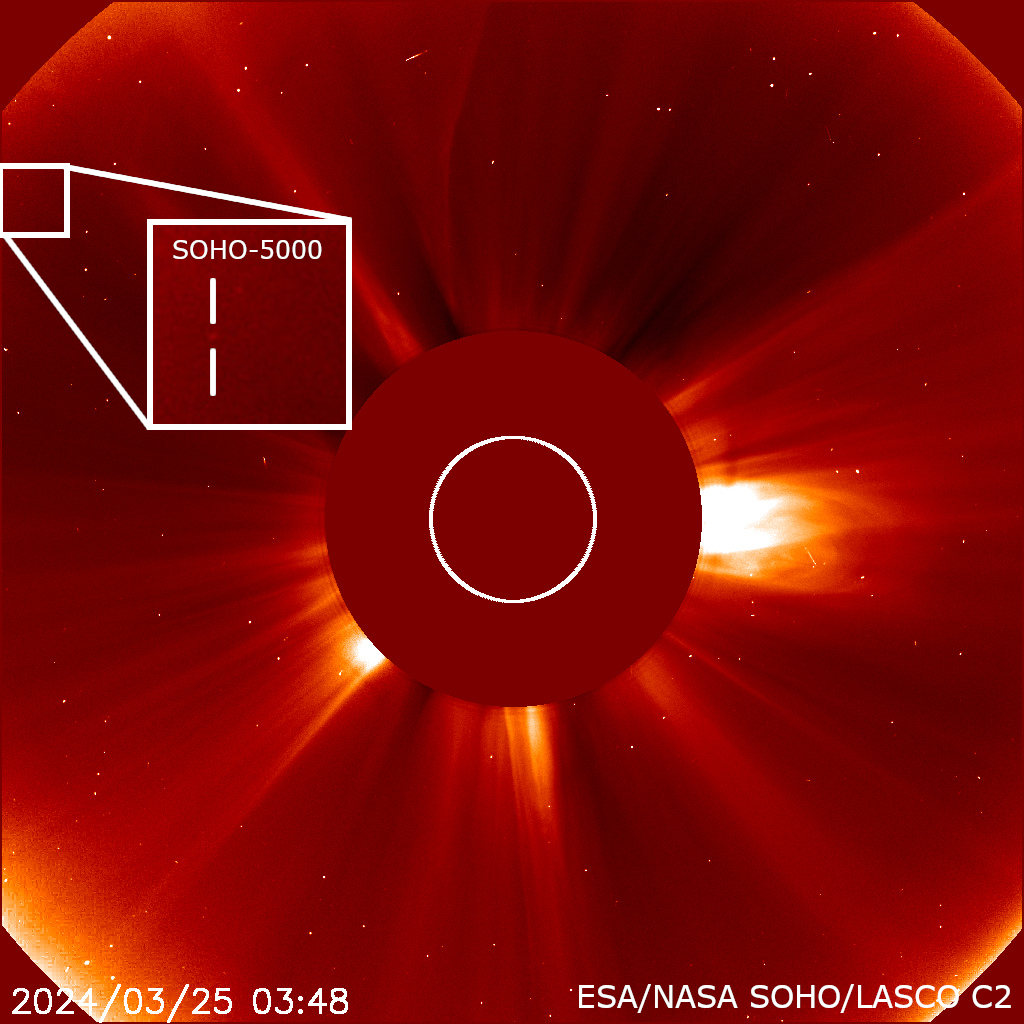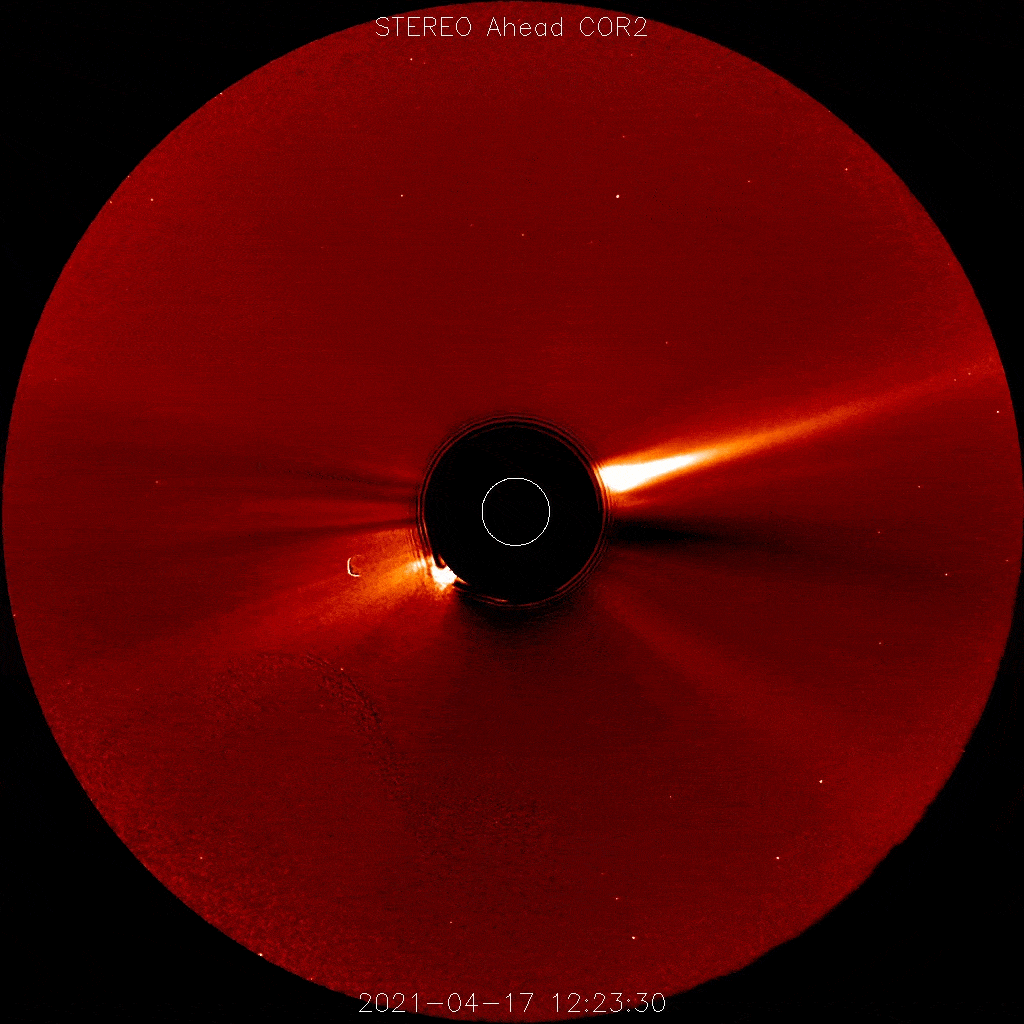SOHO
Solar and Heliospheric Observatory


What is SOHO?
SOHO is the longest-lived Sun-watching satellite to date. Numerous mission extensions have enabled the spacecraft to observe two 11-year solar cycles and to discover thousands of comets.
- SOHO is a cooperative international project between ESA and NASA. NASA contributed three instruments and launch services. ESA leads the mission.
- During its pioneering career, SOHO has returned a wealth of new information about the Sun—from its core to its outer atmosphere and the solar wind.
- SOHO monitors the effects of space weather on our planet, and it plays a vital role in forecasting potentially dangerous solar storms.
- SOHO is the most prolific discoverer of comets in astronomical history, with more than 5,000 tracked during their encounters with the Sun.
Nation | European Space Agency (ESA) and United States of America (USA) |
Objective(s) | Sun–Earth L1 Lagrange Point |
Spacecraft | SOHO |
Spacecraft Mass | 4,109 pounds (1,864 kilograms) |
Mission Design and Management | ESA / NASA |
Launch Vehicle | Atlas Centaur IIAS (AC-121 / Atlas IIAS no. 8206 / Centaur II) |
Launch Date and Time | Dec. 2, 1995 / 08:08:01 UT |
Launch Site | Cape Canaveral, Fla. / Launch Complex 36B |
Scientific Instruments | 1. Solar-Ultraviolet Measurements of Emitted Radiation Experiment (SUMER) 2. Coronal Diagnostic Spectrometer (CDS) 3. Extreme Ultraviolet Imaging Telescope (EIT) 4. Ultraviolet Coronograph Spectrometer (UVCS) 5. Large Angle and Spectrometric Coronograph (LASCO) 6. Solar Wind Anisotropies Experiment (SWAN) 7. Charge, Element, and Isotope Analysis Experiment (CELIAS) 8. Comprehensive Suprathermal and Energetic Particle Analyzer (COSTEP) 9. Energetic and Relativistic Nuclei and Electron Experiment (ERNE) 10. Global Oscillations at Low Frequencies Experiment (GOLF) 11. Variability of Solar Irradiance and Gravity Oscillations Experiment (VIRGO) 12. Michelson Doppler Imager/Solar Oscillations Investigation (MDI/SOI) |
Key Dates
Dec. 2, 1995: Launch
Feb. 14, 1996: Sun-Earth L1 orbit insertion
March 25, 2024: 5,000 comets discovered
In Depth: SOHO
The ESA-sponsored Solar and Heliospheric Observatory (SOHO) carries 12 scientific instruments to study the solar atmosphere, helioseismology, and the solar wind. Information from the mission has allowed scientists to learn more about the Sun’s internal structure and dynamics, the chromosphere, the corona, and solar particles.
The SOHO and Cluster missions, part of ESA’s Solar Terrestrial Science Programme (STSP), are ESA’s contributions to the International Solar Terrestrial Physics (ISTP) program, which has involved the work of other spacecraft such as Wind and ACE, which, like SOHO, operate in the vicinity of the Sun-Earth L1 point.
NASA contributed three instruments to SOHO as well as launch and flight operations support.
About two months after launch, on Feb. 14, 1996, SOHO was placed at a distance of 932,000 miles (1.5 million kilometers) from Earth in an elliptical Lissajous orbit around the L1 libration point where it takes approximately six months to orbit L1 (while the L1 itself orbits the Sun every 12 months).
The spacecraft returned its first image Dec. 19, 1995, and was fully commissioned for operations by April 16, 1996. SOHO finished its planned two-year study of the Sun’s atmosphere, surface, and interior in April 1998.
Communications with the spacecraft were interrupted for four months beginning June 24, 1998, after which the spacecraft was apparently spinning, losing electrical power, and not pointing at the Sun. After intensive search efforts, by Sept. 25, 1998, controllers managed to regain control and return SOHO to “normal mode.” Except for three instruments, the spacecraft was functional and was declared operational once again by mid-October 1998.
Because of the failure of onboard gyros, ESA developed a special method of orientation, using reaction wheels instead of gyros, which was successfully implemented beginning Feb. 1, 1999.
SOHO’s original lifetime was three years (to 1998), but SOHO’s mission at L1 has been extended several times and continues to provide valuable information about the Sun.
One of SOHO’s most important discoveries has been locating the origin of the fast solar wind at the corners of honeycomb-shaped magnetic fields surrounding the edges of large bubbling cells located near the Sun’s poles.
Another has been its discovery, as of March 2024, of over 5,000 comets (more than one-half of all known comets), by over 70 people representing 18 different nations. These discoveries were made possible because of the LASCO instrument that blocks out the Sun’s glare, rendering comets visible.
In December 2015, SOHO marked 20 years of continuous operation, having fundamentally changed our conception of the Sun “from a picture of a static, unchanging object in the sky to the dynamic beast it is,” in the words of Bernhard Fleck, the ESA project scientist for SOHO.
The longevity of the mission has allowed SOHO to cover two full 11-year solar cycles and the beginning of a new one. One of the high points of the mission was SOHO’s observation of a bright comet plunging toward the Sun on Aug. 3-4, 2016, at a velocity of nearly 1.3 million miles per hour (2.1 million kilometers per hour).
Additional Resources
Key Source
Siddiqi, Asif A. Beyond Earth: A Chronicle of Deep Space Exploration, 1958-2016. NASA History Program Office, 2018.









